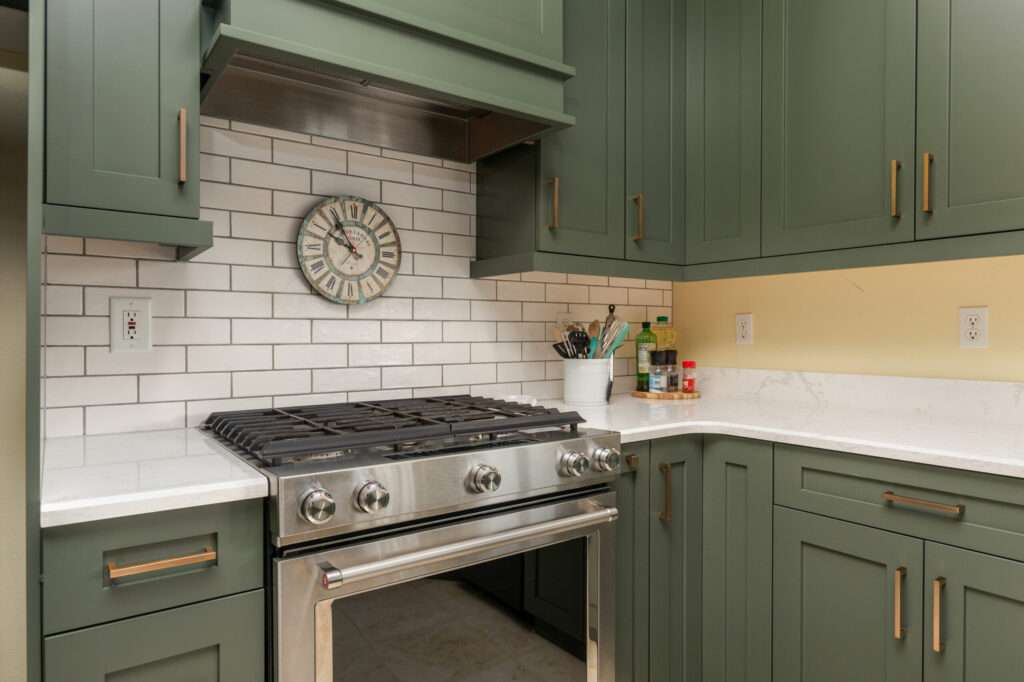Note: the following cabinet care instructions apply to all wood cabinets, wood textures of cabinets, laminates, UV lacquer, acrylic, clear-coated stained wood, and painted surfaces unless otherwise stated.
Maintaining a house can have its quirks. Gutters must be cleared of leaves, the lawn should be mowed, trees and hedges could be pruned, and the garden needs to be overhauled, which is just the property’s exterior.
Inside, the floors must be washed; walls may need a fresh coat of paint; the furnace filters should have been changed months ago; the list could go on.
However, kitchen cabinets require just as much maintenance and cleaning care as any other item in the household. With that said, let’s get into it.
How Often Should I Do Cabinet Cleaning?
With longevity in mind, kitchen cabinets should be cleaned routinely or based on the accumulated mess.
The lifespan of the cabinet is also based on how they are cleaned. For example, a quick dry dusting may scratch the cabinet surfaces if done with a dry cloth. Residues from smoke, cooking vapours, grease, and hand or body oils can be cleaned with a cloth dampened with mild soap and warm water. Remember to use a clean, soft microfiber cloth to do your cabinet cleaning.
All products and finishes offered by Decor have excellent resistance to foods, beverages, and household agents found in a typical kitchen or bathroom. But keep in mind these surfaces are scratch-resistant, not scratch-proof.
Helpful Hint: For regular cleaning of all cabinet doors and exterior & interior surfaces, if wood cabinetry is used, always wipe in the same direction as the wood grain.

Common Cleaners and Supplies for Cabinet Care
The safest options for cleaning your kitchen cabinets are a mixture of warm water with an equal amount of distilled white vinegar or a small amount of dish soap.
Vinegar and Water
The first option of distilled white vinegar in warm water is one of the safest methods to use on most painted doors and wood surfaces. To make this cleaner, all that is needed is a fifty-fifty mix of vinegar and warm water. Vinegar is approximately five percent acetic acid, which breaks down the structure of some dirt, oils, films, stains, and bacteria. The acetic agent can harm the cabinet surface, so test this solution with a damp cloth in an inconspicuous area first. (Not recommended on Melamine, UV Lacquer, Acrylic, and Laminate)
Dish Soap and Water Formula for Cabinet Care
Another cleaning alternative is dish soap (not dishwasher liquid) and water. Dish soaps are one of the safest and most effective options for cleaning various surfaces, such as wood surfaces, painted doors, and most other finishes. This is Decor’s recommended method for cleaning your cabinets. Dish soaps can degrease, break down solids, effectively remove bacteria, do not irritate the skin, and has a pleasant smell.
Use a Soft Cloth
A soft, damp cloth, such as an old white cotton t-shirt or white microfiber cloth, should be used instead of abrasive sponges, dish towels/materials, or coloured microfiber cloth. Dish towels are to be avoided since most can contain soaps, grease, and other soil that can harm the cabinets’ finished surface—following shortly after the initial cleaning, dry with another soft cloth or absorbent paper towel.
Things to avoid
Avoid abrasive cleaners. Most cleaning products containing silicones, waxes, polishes, abrasives, acids, alkaline solid solvents, alcohol, ammonia, or bleach should be avoided as much as possible. These types of products may cause irreversible damage to the cabinet surface or finish. The damage to the finish may leave a residue that airborne grease will stick to. Always test cleaning products on a small, inconspicuous area before a full-fledged cleaning.
While some cleaning and cabinet care products are specifically for cabinet and furniture cleaning, most still contain silicones, waxes, or polishes. We still don’t recommend using these products.
Ensure that when cleaning any glass in your kitchen, don’t get any glass cleaner on the kitchen cabinets.
If you use these, below are some things to note. Use them at your own risk.

Silicone Cleaners
Silicone cleaners are very common and can offer a high degree of shine. A side effect of silicone-based cleaners is that they can seep into even the highest-quality finishes, creating a barrier that makes it impossible to refinish or touch up specific blemishes when necessary.
Wax-Based Cleaners
Wax-based cleaners are not needed on any of our finishes. Although it will provide a shine to the finish, regular use of wax cleaners will result in a wax film buildup, making refinishing or repair work difficult. This wax film attracts other pollutants, such as dirt, smoke, and grease, released into the air. Attempting to clean will cause noticeable streaks and smudges on the finish. Since many wax-based cleaners also contain particulates that may damage the finish, they are not recommended.
Wood Polishes
Wood polishes contain detergents to remove dirt. These emulsifiers give it the power to clean the vast majority of grit and grime, leaving behind a barrier of mineral oil that repels dirt and moisture while also not leaving a wax or silicone residue.
So, between a silicone, wax-based, or wood polish cleaner, the wood polisher is the best choice…yes is still not recommended.
If you’re unsure about a cleaner or cloth, always test it on a small inconspicuous area first.
Step-by-Step Walkthrough for Cabinet Care
Distilled White Vinegar with Water
Combine a 1-to-1 ratio, or equal parts, of vinegar and warm water in a corresponding container. Use the proper cloth to mix it. Wring the cloth out, so you end up with a damp cloth that isn’t dripping. Limit excess moisture as much as possible.
Begin by testing on an inconspicuous corner before doing a full-fledged cleaning. This can prevent any discoloration or permanent damage on cabinet doors or any other surface that is instantly visible.
Wipe over greasy cabinets with a damp cloth until clean. If applicable, follow the grain of the wood and limit excess water.
For stubborn messes, repeat the process until clean.
In a separate bowl/container with a new batch of the vinegar and water mixture, soak a fresh soft cloth, and wring it out, so it’s damp – not dripping. Wipe down the areas you just washed to remove any remaining grease and excess mixture left behind.
If anything was left on your cabinets, repeat until you’re satisfied with the result.
Afterward, immediately dry the surfaces with a clean cloth. This will prevent streaking.
Let cabinets dry, preferably by air.

Dish Soap and Water
Apply a few drops of dish detergent to a bowl of warm water as you would for washing dishes by hand.
Begin by testing on an inconspicuous corner before doing a full-fledged cleaning.
Using the cloth, mix the cleaning solution. Squeeze the cloth in the mixture until suds form. Wring the cloth out, so it’s damp but not dripping.
Wipe over greasy cabinets with the soapy cloth until the soil is removed. If applicable, follow the grain of the wood.
Extra sticky wood cabinets might require you to repeat. So, if anything was left on your cabinets, repeat until you’re satisfied with the result.
For those stubborn messes, apply a squirt of dish soap directly to the cloth under warm running water, then gently rub the greasy surface.
Using a separate bowl of clean water, soak a fresh, clean cloth, wringing it out so it’s damp but not dripping. Wipe down the cabinets and remove any remaining residue, limiting excess water.
Dry the surfaces immediately with a clean, dry cloth to prevent streaking.
Let cabinets dry, preferably by air.
The Dos and Do Nots of Cabinet Care
Do's:
-
Wipe up spills promptly and dry completely. Especially in areas near the sink, stove, dishwasher, on joints, and around any cutouts. This includes bathroom cabinets, not just kitchen cabinets.
-
Clean one cabinet at a time.
-
Clean routinely to avoid long-term damage from water, food, smoke, grease, and oil buildup.
-
Wipe up mustard spatters immediately, as mustard will stain painted wood and some other finishes very quickly.
-
Keep the finish dry, whether painted wood, laminate surfaces, solid wood, or melamine.
-
Clean with a white lint-free cloth or microfiber towel (microfiber towels are not recommended on Acrylic or UV Lacquer material).
-
Use a mild detergent or soap and warm water (not dishwasher liquid).
-
Follow up with clean water after cleaning with any cleaning solution.
-
Wipe gently when cleaning with a damp or dry cloth.
-
Use the pulls or knobs to open and close cabinet doors and drawers. This will prevent long-term damage and gloss areas on the cabinet door from forming around the pulls and knobs.
Do Nots:
-
Do not soak the surfaces when cleaning. Permanent damage could occur.
-
Do not use coloured cloths, microfiber towels or any abrasive cleaners; use a mild detergent and a soft cloth instead.
-
Do not wipe cabinets with a dishcloth or sponge, as these contain harsh soaps, grease and soil that damage the finish. Use a microfiber cloth instead.
-
Do not scrub or rub excessively in one location. This will cause the cabinet finish to be polished, creating a shiner surface in that one place. This is especially important with low-sheen finishes.
-
Do not use products with bleach, ammonia, silicone, waxes, polishes, or abrasive additives
-
Do not allow water or liquids to be in contact with finished surfaces giving your cabinet finish prolonged exposure. This could lead to excessive moisture being absorbed, and the finished wood could bulge from soaking up too much moisture.
-
Do not use abrasive cleaning pads (Scotch Bright), sponges, magic erasers, steel wool, etc., on cabinet surfaces. Steel wool will leave scratches that make you want to tear your hair out.
-
Do not allow oven cleaners to contact the finish. Wood cabinets may end up discoloured.
-
Do not place kitchen appliances where heat is directed onto the finished surfaces.
-
If possible, do not have your kitchen cabinets in direct sunlight to avoid any colour fading.
-
Avoid steam from kettles, boiling pots, etc., to be directed at the underside or bottom of the cabinets. Wood cabinetry is especially susceptible to moisture that can build up from the steam.
-
Do not drape the damp cloth over cabinet doors – or anything else that\’s damp or wet for that matter. The moisture will cause permanent damage over time.
-
Do not use steam cleaning machines. Again, wood cabinets can become permanently damaged from soaking up moisture.
Wear and Tear Around Knobs and Handles
The knob handles and surrounding areas will show the most wear with frequent use. No matter how often we wash our hands, human skin always contains natural oils that keep our skin protected from drying out. It’s most noticeable on surfaces like glass, stainless steel, or other similar surfaces. Oil from your skin, food, hand lotions, hand creams, and some detergents may break down the finish entirely over time.
Don't Simply Wipe Flat Finishes
On a flat finish, simply wiping these areas down may cause a greasy spot to appear, resulting in only polishing the area even more. This will show up more with a painted surface or a lower gloss, clear or opaque finish.

Polished Areas are Part of Normal Wear and Tear
The polished or glossy area where the surface is repeatedly in contact with fingers rubbing against the finish is considered normal “wear and tear” and not a defect. This polished or glossy area is not as evident on a higher gloss finish. As described above, the best thing to do is clean with mild dish soap and water regularly.
Final Thoughts
Caring for your cabinets is simple but should be done just as often as the rest of your home.
Stay away from harsh cleaners and use a soft cloth when cleaning, and you should have long-lasting, good-looking cabinets.













